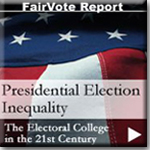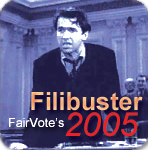 New districts in harmony with one person, one vote
New districts in harmony with one person, one voteBy Jack Santucci
Published July 9th 2006 in Amarillo Globe-News
A voting-rights lawsuit calls for changes to winner-take-all, at-large elections for city commission. The debate so far has fixated on two winner-take-all options. The current at-large system leads to foregone, discriminatory results.
Yet single-winner districts would require multiple ballots and voters using two distinct systems at the same time.
Every voter would get a district-specific city commission ballot in addition to the citywide cumulative ballot, both of which voters mark differently.
The city should take a lesson from the last such experience in the 1990s, when a voting rights case challenged the at-large system used to elect the AISD board.
On one hand, at-large, winner-take-all elections had to go because they systematically locked the city's racial minority population - more than a quarter of its residents - out of the AISD board. Until 1999, only three racial minorities had ever served: two appointed and one elected twice in the 1970s. None of the 10 Hispanic and African-American candidates from 1980 to 1996 was successful.
On the other hand, Amarillo residents were unwilling to fragment their city in order to draw one district where African-Americans and Latinos were a majority of voters. The city knew districts could mean petty campaigns and competition for resources at the expense of a citywide focus. Voters would have gone from having many reps to just one.
Both sides compromised: maintain a citywide election and provide all groups the opportunity to win representation through cumulative voting.
Everyone has a vote for every seat to be elected, but they are free to allocate those votes however they wish, including "plumping" more than one vote on a favorite candidate. Everyone has the same voting strength, so the method is consistent with "one person, one vote" - more so than the current system.
Winner-take-all City Commission elections encourage "bullet" voting by groups that rightly calculate that using all their votes can disadvantage a preferred candidate. So those groups use a fraction of their strength and still fail to elect their picks.
Since cumulative voting's 2000 implementation, African-American, Latino and white members have sat on the AISD board. At the same time, all represent the larger community.
And this time, cumulative voting would add the benefit of streamlining Amarillo's election system. There would be fewer ballots to print. There would be no need to program voting machines differently - by district or method. There would be less confusion among voters than when they're asked to use two methods at once.
One reason districts get most attention is the desire for neighborhood representation. Candidates from high-turnout neighborhoods might sweep at-large elections. Single-member districts will ensure bargaining power for other areas.
But opponents suggest single-member districts would turn local bodies into a microcosm of Congress - members rolling logs for pork projects to benefit their narrow slivers of the electorate, rather than the community as a whole.
Cumulative voting would let voters elect the members who'd ensure the desired use of tax dollars - whether they're to be used in a neighborhood or to benefit an area larger than a predetermined district.
That's because cumulative voting lets every like-minded grouping of voters elect a fair share of representatives - racial, political or neighborhood-based. It also avoids the redistricting wars that afflict America every 10 years, when lines must be redrawn. Think gerrymandering, consultants, rampant incumbency and a potential political battle following every census.
Cumulative voting is fair, and it works. Amarillo should build on past success and give voters a consistent system for all elections. It's the best way to bring a community together.



